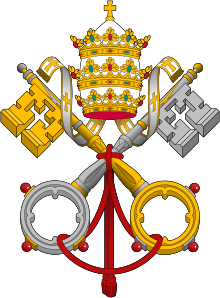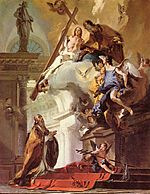Portal:Catholic Church
Introduction The Catholic Church, also known as the Roman Catholic Church, is the largest Christian church, with 1.28 to 1.39 billion baptized Catholics worldwide as of 2024. It is among the world's oldest and largest international institutions and has played a prominent role in the history and development of Western civilization. The church consists of 24 sui iuris churches, including the Latin Church and 23 Eastern Catholic Churches, which comprise almost 3,500 dioceses and eparchies around the world. The pope, who is the bishop of Rome, is the chief pastor of the church. The Diocese of Rome, known as the Holy See, is the central governing authority of the church. The administrative body of the Holy See, the Roman Curia, has its principal offices in Vatican City, which is a small, independent city-state and enclave within the city of Rome, of which the pope is head of state. The core beliefs of Catholicism are found in the Nicene Creed. The Catholic Church teaches that it is the one, holy, catholic and apostolic church founded by Jesus Christ in his Great Commission, that its bishops are the successors of Christ's apostles, and that the pope is the successor to Saint Peter, upon whom primacy was conferred by Jesus Christ. It maintains that it practises the original Christian faith taught by the apostles, preserving the faith infallibly through scripture and sacred tradition as authentically interpreted through the magisterium of the church. The Roman Rite and others of the Latin Church, the Eastern Catholic liturgies, and institutes such as mendicant orders, enclosed monastic orders and third orders reflect a variety of theological and spiritual emphases in the church. Of its seven sacraments, the Eucharist is the principal one, celebrated liturgically in the Mass. The church teaches that through consecration by a priest, the sacrificial bread and wine become the body and blood of Christ. The Virgin Mary is venerated as the Perpetual Virgin, Mother of God, and Queen of Heaven; she is honoured in dogmas and devotions. Catholic social teaching emphasizes voluntary support for the sick, the poor, and the afflicted through the corporal and spiritual works of mercy. The Catholic Church operates tens of thousands of Catholic schools, universities and colleges, hospitals, and orphanages around the world, and is the largest non-government provider of education and health care in the world. Among its other social services are numerous charitable and humanitarian organizations. (Full article...) Selected article
 The Roman Catholic Church, officially known as the Catholic Church, is the world's largest Christian church, representing over half of all Christians and one sixth of the world's population. It is made up of one Western and 23 Eastern Catholic churches and divided into 2,782 jurisdictional areas around the world. These Churches look to the Pope, currently Pope Francis, as their highest visible authority in matters of faith, morals, and church governance. The primary mission of the Catholic Church is to spread the message of Jesus Christ, found in the four Gospels, and to administer sacraments that aid the spiritual growth of its members. To further its mission, the Church operates social programs and institutions throughout the world. These include schools, universities, hospitals, missions and shelters, as well as Catholic Relief Services and Catholic Charities that help the poor, families, the elderly and the sick.
Selected image
 Credit: LivioAndronico The Trevi Fountain is the largest — standing 25.9 meters (85 feet) high and 19.8 meters (65 feet) wide — and most ambitious of the Baroque fountains of Rome. Competitions had become the rage during the Baroque era to design buildings, fountains, and even the Spanish Steps. In 1730 Pope Clement XII organized a contest in which Nicola Salvi initially lost to Alessandro Galilei — but due to the outcry in Rome over the fact that a Florentine won, Salvi was awarded the commission anyway. Work began in 1732, and the fountain was completed in 1762, long after Clement's death, when Pietro Bracci's 'Neptune' was set in the central niche. Selected biography
 Henry de Lichton (de Lychtone, Leighton) (d. 1440), was a medieval Scottish prelate and diplomat, who, serving as Bishop of Moray (1414–1422) and Bishop of Aberdeen (1422–1440), became a significant patron of the church, a cathedral builder and a writer. He also served King James I of Scotland as a diplomat in England, France and Italy. He was born in the diocese of Brechin (probably Angus) somewhere between 1369 and 1379 to Henry and Janet Lichton. He was exceptionally well educated for his time, attending the University of Orléans and possibly the University of St Andrews, earning licentiates in civil law and canon law, a bachelorate in canon law and a doctorate in canon law, all achieved between 1394 and 1415; he attained an additional doctorate — in civil law — by 1436. Lichton followed an ecclesiastical career simultaneously with his studies. The first notice of this career comes in 1392, when he was vicar of Markinch in Fife, a vicariate of St Andrews Cathedral Priory.
Did you know...

Related portalsFeast Day of November 23
Little is known about Clement's life. Tertullian claimed that Clement was ordained by Saint Peter. Early church lists place him as the second or third bishop of Rome. Eusebius, in his book Church History mentioned Clement as the third bishop of Rome and as the "co-laborer" of Paul. In Against Heresies, Irenaeus describes Clement as the successor to Anacletus (third bishop of Rome), and a personal acquaintance of the Apostles. According to the Annuario Pontificio, Clement was the fourth bishop of Rome, holding office at the very end of the 1st century. It is likely that Clement died in exile, and was possibly martyred. According to apocryphal stories dating back to the 4th century by authors such as Rufinus, Clement was imprisoned by Roman Emperor Trajan, and was executed by being tied to an anchor and thrown into the sea. The Liber Pontificalis states that Clement died in Greece in the third year of Trajan's reign, or 100 AD. (Full article...)
Selected quote

News
SubcategoriesTopics
The Holy Bible:
Particular Churches (grouped by liturgical rite):
Things you can do
External resourcesWikiProjectsAssociated WikimediaThe following Wikimedia Foundation sister projects provide more on this subject:
Discover Wikipedia using portals |

































